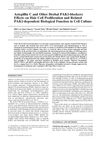PAK4 Signaling in Health and Disease: Defining the PAK4–CREB Axis
February 2019
in “
Experimental & Molecular Medicine
”

TLDR PAK4 is crucial in cancer progression, brain development, and could be a therapeutic target, especially through the PAK4-CREB axis.
The review article discussed the role of p21-Activated kinase 4 (PAK4) in various cellular functions and its implications in health and disease, focusing on the PAK4-CREB axis. PAK4 was identified as a key player in cancer progression, particularly in prostate cancer, influencing processes such as epithelial-mesenchymal transition, invasion, and metastasis. It was also essential for embryonic brain development and had neuroprotective functions, with its activity being protective for dopaminergic neurons in Parkinson's disease. In melanogenesis, PAK4 was a central regulator, linking the cAMP-PKA and Wnt/β-catenin pathways. Despite the potential of PAK4 as a therapeutic target, specific inhibitors had not been successful at the time. The review highlighted the emerging role of the transcription factor CREB as a novel effector of PAK4, with significant implications due to CREB's involvement in regulating a wide range of genes. The PAK4-CREB axis was identified as a potential therapeutic target, suggesting its potential in treating related diseases.





